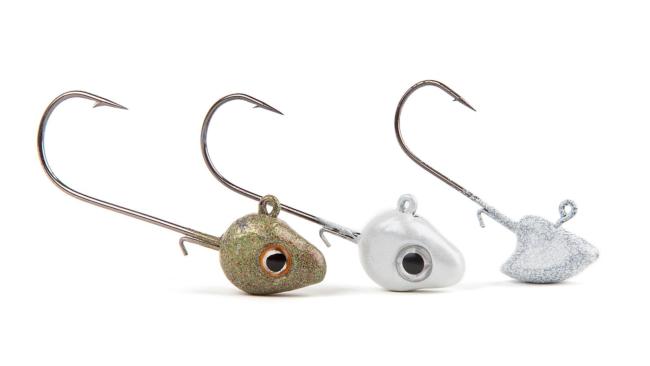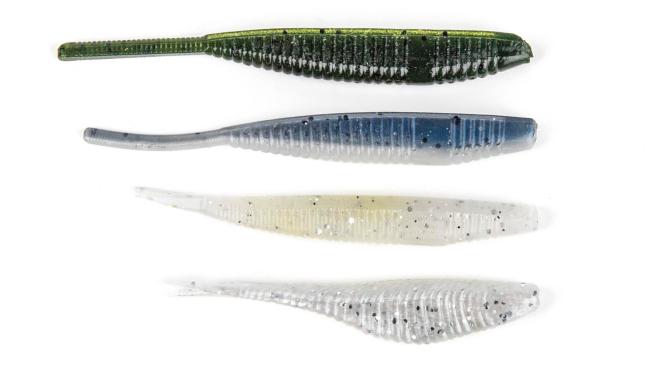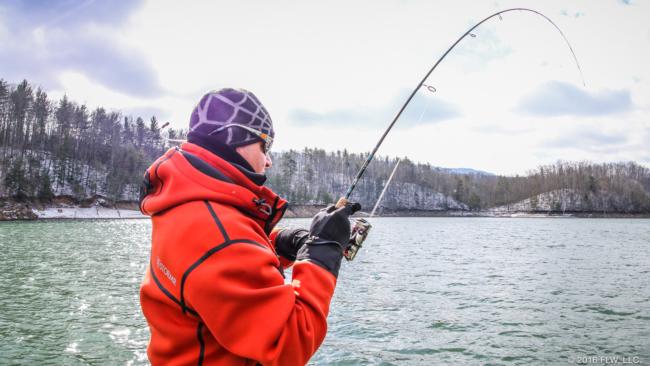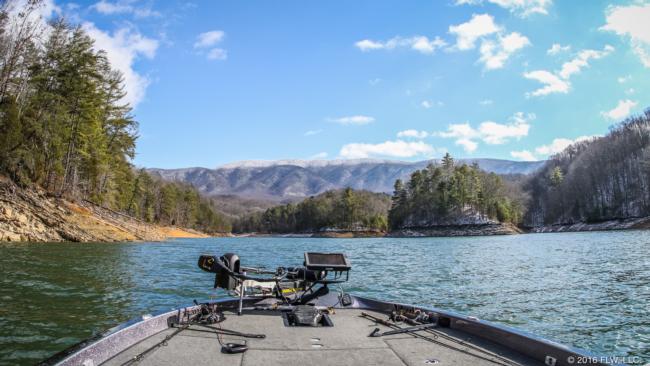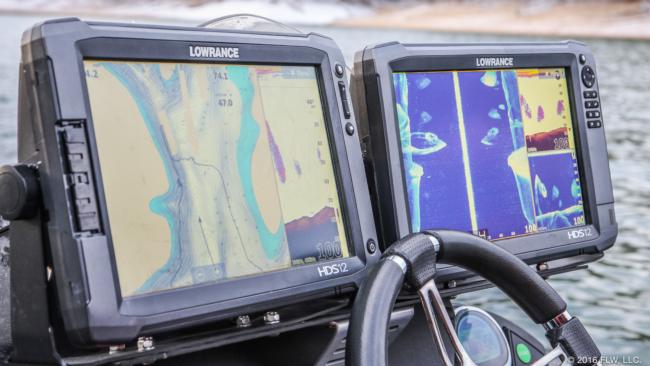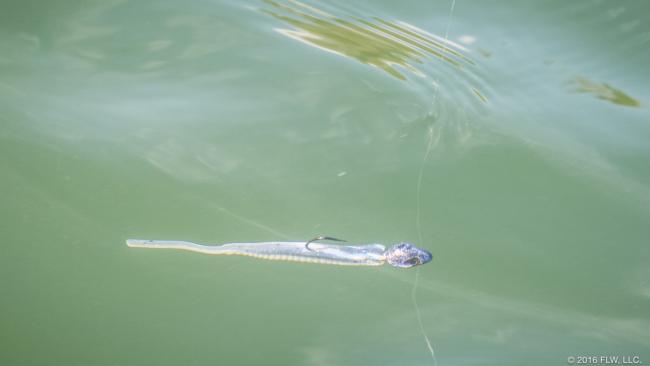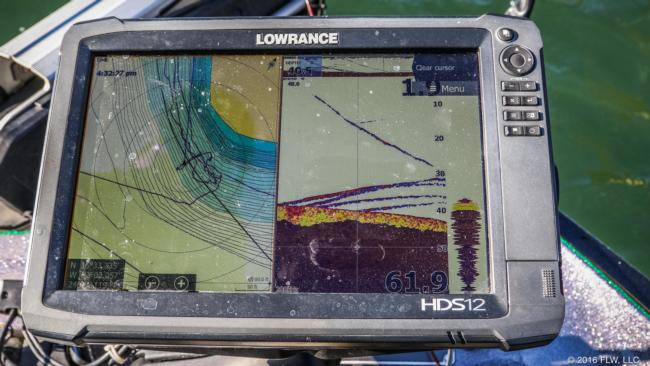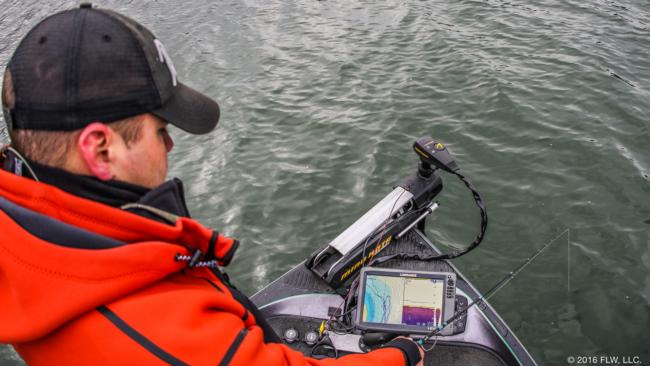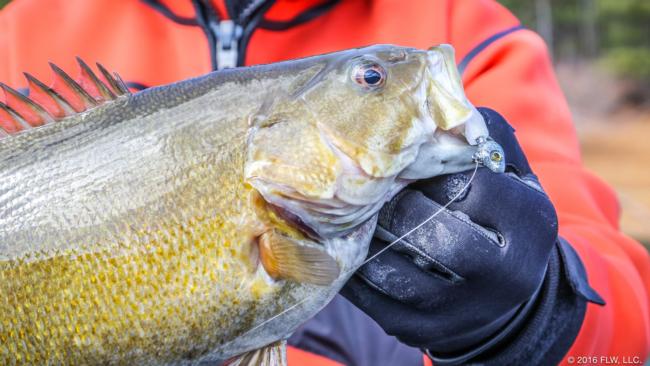Fishing the Damiki Rig in Winter
This subtle minnow-imitating technique can be a smallmouth killer in cold weather
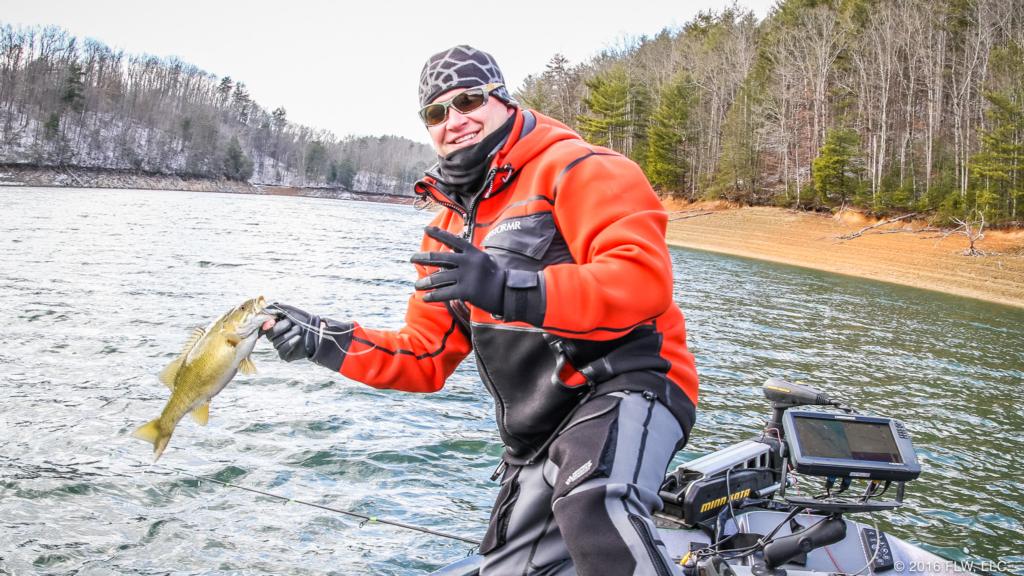
Editor's note: This article originally appeared in February 2017. Derrick Snavely will be fishing the FLW Tour full time again in 2019.
The two lines careen toward each other on the Lowrance screen. The top line, representing Derrick Snavely’s bait sinking into the waters of South Holston Lake, slopes down from left to right. The other, generated by a predatory smallmouth torpedoing up from the depths, is a mirror image.
Just before “impact,” Snavely flips the bail closed on his spinning reel and then pauses. His bait is completely still. On the screen, the two lines level out parallel to each other for a few seconds, as the entire scenario is put on pause while the bass debates whether or not Snavely’s subtle jighead-minnow combo, known in these parts as a “Damiki rig,” is as good to eat as it looks.
The former FLW Tour pro and 2017 T-H Marine FLW Bass Fishing League All-American qualifier has seen such a scenario play out on his depth finder many times before. “Video game fishing” with a Damiki rig combo has become a go-to technique in the clear mountain reservoirs of the Appalachians during the last few seasons, and it works especially well on the coldest days – days like this one, with the temperature in the 20s and fresh snow on the slopes. Snavely fishes through the winter every season, so he’s dialed in on the technique and knows how to read a fish’s intentions just by what he sees on the depth finder.
With this fish, he waits, his finger on the line so he can feel for even the subtlest take. It’s too much for this bass to ignore, and the two lines converge on the screen into one thick band. A long second passes before Snavely snaps the rod up with a quick, firm hookset.
He races with the reel to take up line as the fish fights toward the surface. It quickly shows itself: an angry 3-pounder. When the fish sees the boat, it makes a late surge that pulls drag. Snavely’s rod doubles over, but he plays down the fish, giving it some time to tire. When the fish nears the surface again, the angler sprawls across the deck of his Ranger. Switching the rod to his right hand, he grabs the line with his left and gently pulls the bass up to the surface. Then Snavely drops the rod and lips the bass into the boat.
He grins as he shows off the chunky smallie, knowing that he just outsmarted an apex predator in the cat-and-mouse game that is Damiki fishing, a dynamite technique that has applications throughout much of the country where smallmouths live.
The rig
The Damiki rig looks to be nothing more than a 3- to 3 1/2-inch minnow-shaped soft plastic rigged on a light jighead, but the details are more complex.
It gets its name from the Damiki Armor Shad, which is a split-tail “fluke-style” bait with a broad “body” up front and a narrow rear end. The Armor Shad (shown at the bottom of the soft plastics photo below) is the original bait used for the technique and is often paired with what locals call an Erie-style jighead (below, far right), which has a 90-degree line tie, a pointed nose and most of the weight molded to the underside of the hook.
Using the proper jighead is important because it needs to balance with the bait in a way that allows the combo to come to rest horizontally in the water. This way the rig mimics a suspended baitfish that’s been stunned by cold water – an easy meal for a smallmouth bass.
Snavely and others have expanded on the original combo, and now local makers are pouring new jigheads and plastics that provide anglers more options.
He relies primarily on a 3/8- or 1/2-ounce Stoney Creek Tackle Minnow-E-Jig Head (above, left and center) and usually either the FoolinBass Custom Baits D-Shad (below, second from the top) or FoolinBass Custom Baits Foolin’ Shad (below, third from the top). The jighead has a 3-D eye and a triangular-shaped head with a wire bait keeper. The baits have parallel ridges molded into their sides, and Snavely cuts off the tip of his bait at the first ridge for a better fit against the back of the jighead. When combined, the jighead and plastic fit together perfectly and look just like a small minnow. Also, Snavely suggests sliding the knot to the backside of the jig’s line tie. This helps keep it horizontal in the water.
Other baits can work for the technique, including the Yamamoto Shad Shape Worm (above, top) and just about any small, soft jerkbait or minnow-shaped drop-shot bait. In warmer conditions, variations of the Damiki rig have some applications in offshore fishing, and larger combos might come into play when bass are more aggressive. In winter, though, it’s primarily a small-bait affair.
For clear-water smallmouths, productive colors range from natural shad patterns, which are quite popular, to shades of green. Determining the best color each day requires experimentation, though Snavely recommends starting with silver flash (translucent grey with silver flakes) or white on cloudy days.
Equipment
Damiki fishing is a finesse technique, so spinning tackle gets the call. Snavely recommends a high-quality drop-shot rod. His preference is a 6-foot, 10-inch G. Loomis NRX 822S DSR, though he’s been experimenting with a rod that’s a bit longer, too.
He pairs the rod with a Shimano Stradic Ci4+, 10-pound-test braid and a leader of Gamma Touch fluorocarbon in 5- to 7-pound test. When the temperature is low enough that the braid is freezing on the spool and not flowing smoothly through the guides, he’ll spray a line conditioner on the spool or perhaps switch to a full spool of 4-pound-test monofilament. The downside of mono in deep water is that it’s not as sensitive as braid, and the stretch in the line makes a good hookset more difficult to achieve. Braid is definitely the line of choice.
Where and when to fish it
The Damiki rig is primarily a wintertime bait, though according to Snavely it has some applications earlier in the season, beginning at about the autumnal equinox in late September. From then until November on the mountain lakes near his Johnson City, Tenn., home, Snavely finds bass grouped together in larger schools than in wintertime. They also relate more to the bottom rather than being suspended. So Snavely targets flats, humps and points and tends to fish the rig with a bit more action.
Later in the year, when the rig really shines, he’s primarily dead-sticking for suspended bass or bass keyed on suspended bait in water deeper than 30 feet. Shallower than that, the fish can be spooked by the boat overhead.
Water temperature is also important for the winter bite.
“Anything 50 degrees or below is good, but 46 to 48 degrees is best,” Snavely says. “You’re mimicking sluggish shad that start to die off when it’s cold. Target any bank, channel, channel swing, ditch or flat where there’s bait.”
Unlike in summer, when offshore bass tend to relate to a defined edge, winter smallmouths can be just about anywhere as long as food is nearby. Shad, alewives and other baitfishes will filter in and out of the main lake and large creeks through ditches, down the center of the creeks or along steep-sloping banks.
That’s why it’s essential to focus on finding bait, versus spending hours searching for schools of bass along distinct contours. Besides, sometimes bass “blend in” with schools of bait on the depth finder and are tough to spot anyway, or they’re so tight to bottom – waiting on bait to drift by overhead – that they’re not visible on the graph.
“A lot of times you just idle around, and you only have to see one fish because they’re so tight to bottom [that you don’t see the rest],” Snavely adds. “It’s not like the summertime where you want to see a bunch of fish schooled up.”
If you mark a fish or two, or if you locate a wad of bait, stop and drop the trolling motor. Snavely says he finds more fish once he shuts off the big motor and is on the front deck, with the bait dropped down.
Finally, weather is a major factor in winter. The fish respond to fronts as they do at any time of year, but strong winds make it tough to stay directly above them, and the resulting waves crashing on banks can set up other patterns that are easier to fish, such as casting a swimbait or crankbait along steep, windblown banks and points.
Cold days and extended periods with low temperatures are usually better than mild days, and sunshine will cause bass to suspend more often, making them more susceptible to the Damiki rig. When they’re suspended, Snavely has found that the fish can be patterned by depth range, so once you find a few, check similar areas elsewhere on the lake.
How to fish it
Fishing the Damiki rig is a bit of a departure from traditional vertical presentations. Unlike a spoon, which is usually jigged and ripped aggressively, or a drop-shot, which is shaken in place, the Damiki rig works best with a dead-sticking presentation.
Snavely often uses it in conjunction with a 2.8-inch Keitech swimbait rigged on a 1/4-ounce jighead. Sometimes the fish show a preference for one or the other. But when they’re on the Damiki rig, that’s when he knows a big bag is possible.
“You definitely get bigger bites on it than the Keitech. I don’t know why,” he says. “But sometimes if they don’t bite you can back off and cast the Keitech and get them to bite.”
To fish the Damiki rig, Snavely starts by setting the frequency on his bow-mounted Lowrance HDS unit to the 200 kHz frequency, and he shuts off his rear graph to eliminate interference. If he has a co-angler on board who’s using the rear graph, he sets the front graph to the medium CHIRP sonar setting.
He works into the wind for control, and eases along at a modest speed, stopping above fish whenever they show up on the graph or just dangling the rig in areas where he believes fish to be.
“Don’t get into a hurry on the trolling motor,” Snavely adds. “If you get in a hurry you’ve gone past them.”
Tempting a bass to bite is a cat-and-mouse game. If Snavely sees a fish on his graph, he drops his bait down and stops it a few feet overhead. If he knows fish are in the area, but can’t see them on the graph, he drops his bait down to within 5 or 10 feet of the bottom. Even though these fish might be hugging the rocks, they’re aggressive enough to swim up a long distance to eat an easy meal. Other times, a fish will come into view above his bait, and he has to readjust quickly.
“If you see one up at, say, 17 feet, reel up past it and stop, and usually it will eat it,” he says.
Regardless of where and how a fish shows up, he keeps the rig above the bass and doesn’t give it any action; in fact, he holds it still. Usually if the fish is willing to swim up toward the bait, it’s going to bite. If it doesn’t, Snavely has a few tricks.
“If one stalls, raise up,” he says. “The farther you can get one to come up, the more likely it is to commit.
“A lot of times what gets them fired up is when you reel up really quick and then drop it back down,” he adds.
Mastering this cat-and-mouse game is the most challenging part of the technique, but it’s also an exciting way to fish. Pay particularly close attention to the bottom band on the depth finder. Sometimes a bass will rise up just far enough off bottom to create a noticeable sonar return that blends in slightly with the bottom. If you see a sudden change in color or thickness of the band, it might be a fish.
Also, if a bass shows up, but quickly disappears, sometimes you can relocate it by turning the trolling motor head. The resulting transducer angle change can bring the bass back into the sonar cone.
The key to the technique is to read the fish and respond to their cues – and to be willing to venture out in cold water and look for fish in the first place. Once you find them, the Damiki rig is an effective tool to pluck them from the depths, and you might be rewarded with some of the biggest bass of the season.

